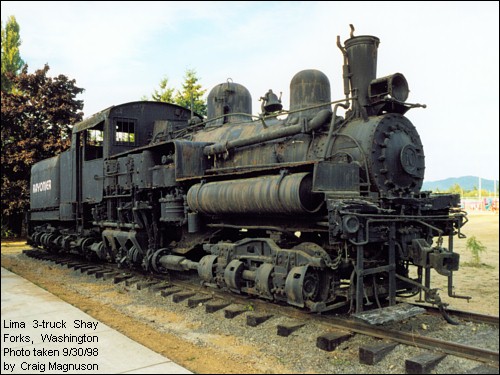Lima 3-Truck Shay Locomotive
|
|
|
The main line track used by Number 10 (see map) went from around the present day location of the Rayonier sorting yard near Forks and from there ran about three miles west, before it curved sharply northeast and headed along the west side of Gunderson Mountain. On the west side of Gunderson Mountain the main line connected to a secondary line, which came down the Sol Duc Valley from Sappho and along the north side of Gunderson Mountain. The secondary line from Sappho was a usable portion of a line, built earlier by Bloedel-Donovan, which originally ran all the way from Sekiu along the Burnt Mountain Road. From the railroad junction on the west side of Gunderson Mountain, the main line continued northeast up along the East Fork Dickey River and up along Skunk Creek to Dickey Camp, about a mile or so from the Dickey-Hoko Summit. From Dickey Camp, the main line continued on over Dickey-Hoko Summit, then turned northwest and went down along the Hoko River, to Hoko Camp, which was located a little over a mile upriver from Hoko Falls. From Hoko Camp, the main line ran northeast down along the Hoko River, to near the mouth of the river on the Strait of Juan de Fuca, then turned east for a few more miles to the salt water log dump at Sekiu. The 3-truck Shay, being a geared “sidewinder” steam locomotive, had a couple features that made it advantageous for steep logging grades. One advantage of the geared drive was that it delivered smoother torque to the drive wheels than locomotives with regular drive rods. The second advantage of the geared drive was that it permitted all wheels to be drive wheels (12-wheel drive), so that the entire weight of the locomotive and tender was on drive wheels. Number 10 has three vertical 13-inch diameter drive cylinders, with a 15-inch stroke, which powered a longitudinal crankshaft. Drive shafts extend forward and backward past the axles of each of the three trucks and each axle was driven by a bevel gear on the drive shaft. The drive shafts have universal joints and slip-joints that compensated for length changes when the trucks turned on curves. The boiler, which operated at 200 lbs. pressure, is off center to the left to provide room for the three vertical drive cylinders on the right side of the locomotive. Since the boiler is off center, it is smaller than could be used on a rod driven locomotive of the same size. The offset boiler also provides for lateral balance since it is offset to the opposite side from the drive cylinders, shafts and gears that are all located on the right side of the locomotive. Lima built 2,770 Shay locomotives of various types, between 1880 and 1945, with most being built before 1930. Rayonier purchased two Baldwin diesel locomotives in 1956, so Number 10 was retired and later donated to the city of Forks in 1959. The railroad was dismantled in the late 1950s through the 1960s, as use declined, with the last track abandoned in 1971 and later removed. The photograph above was taken on September 30, 1998, just before work started to construct a shelter over the locomotive to protect it from rain. Corrosion caused by the wet, coastal, climate is evident in the photograph. |
|
|
|
Click here to read my other railroad history page.
Update: Repainting of the locomotive was completed in July 2001. |
|
Copyright © by Andrew Craig Magnuson |
|
 The old Rayonier logging steam locomotive at Tillicum
Park in Forks, Washington is a Pacific Coast class, 3-truck Shay, built by the Lima Locomotive Works, Inc.,
in Lima, Ohio. The three sets of wheel assemblies, with four wheels each, are what are referred to as the
trucks. The locomotive, serial no. 3348, was built in April 1930 and first operated as the Ozette Timber
Company, Number 10, 3-truck Shay and then later as the Rayonier, Number 10, 3-truck Shay. The Number
10 was operated by both owners around the same general area, north of Forks.
The old Rayonier logging steam locomotive at Tillicum
Park in Forks, Washington is a Pacific Coast class, 3-truck Shay, built by the Lima Locomotive Works, Inc.,
in Lima, Ohio. The three sets of wheel assemblies, with four wheels each, are what are referred to as the
trucks. The locomotive, serial no. 3348, was built in April 1930 and first operated as the Ozette Timber
Company, Number 10, 3-truck Shay and then later as the Rayonier, Number 10, 3-truck Shay. The Number
10 was operated by both owners around the same general area, north of Forks.

